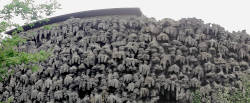Cave Replicas

Cave replicas, i.e. artificial caves modelled on real caves, are often built for didactic or aesthetic reasons.
The first group is located in a museum, usually a
 Cave and Karst Museum,
and allows young and old to visit a cave, including the disabled of course, as the replica has no need for steps so that the copies can easily be made barrier-free.
In addition, such caves can offer a somewhat less extreme caving experience and serve as educational caves.
And then there is a second group that is built to create a beautiful place.
Here the
Cave and Karst Museum,
and allows young and old to visit a cave, including the disabled of course, as the replica has no need for steps so that the copies can easily be made barrier-free.
In addition, such caves can offer a somewhat less extreme caving experience and serve as educational caves.
And then there is a second group that is built to create a beautiful place.
Here the
 Grotto,
a seemingly underground space that is cave-like, overlaps with the cave replicas.
Some caves are so fragile and yet still so important to mankind that it is important to protect them and still make them accessible to the public.
However, these are picture caves, the pictures are the sensitive part, and there is a separate page for these
Grotto,
a seemingly underground space that is cave-like, overlaps with the cave replicas.
Some caves are so fragile and yet still so important to mankind that it is important to protect them and still make them accessible to the public.
However, these are picture caves, the pictures are the sensitive part, and there is a separate page for these
 Painted Cave Replicas.
Painted Cave Replicas.
The grottoes developed in the 18th and 19th centuries, primarily as garden architecture. Later, they were also integrated into palaces and other buildings. At some point, the wild orgy of decoration gave way to more realistic cave scenes. Then came the idea of presenting such cave copies at world exhibitions or other events. The cases in which speleothems were removed from a cave and placed in a kind of labyrinth to create a kind of artificial cave were a real low point. The real stalactites were supposed to make the copy look more lifelike. Unfortunately, this had two disadvantages: The cave was destroyed, and the result was still not really satisfactory. A famous negative example was the so-called model cave of Keith and Allabaugh, who cleared out parts of Bethlehem Cave, SD, U.S.A.
 Cueva de Altamira, es
Cueva de Altamira, es Hidden River Cave & American Cave Museum, KY, usa
Hidden River Cave & American Cave Museum, KY, usa Bat Cave, ca
Bat Cave, ca Exposition Grotte Chauvet, fr
Exposition Grotte Chauvet, fr Grotta dei Cristalli, ch
Grotta dei Cristalli, ch Florida Museum of Natural History, FL, usa
Florida Museum of Natural History, FL, usa Grotesquery, cz
Grotesquery, cz Kunming Natural History Museum of Zoology, cn
Kunming Natural History Museum of Zoology, cn Grotte de Lascaux, fr
Grotte de Lascaux, fr Tamborine Mountain Glow Worm Caves, au
Tamborine Mountain Glow Worm Caves, au Wienerwaldmuseum, at
Wienerwaldmuseum, at
Literature
- Mélanie Duval, Christophe Gauchon, Charlotte Malgat (2019):
Rock Art cave and replica: what kind of Heritage experience?,
Colloque Sense and Sustainability, International Conference on archaeology and tourism, Zagreb, 6-10 May 2019, Croatie.
online
 Search DuckDuckGo for "Cave Replicas"
Search DuckDuckGo for "Cave Replicas" Cave Replicas: Between a Rock and an Art Place (visited: 01-NOV-2020)
Cave Replicas: Between a Rock and an Art Place (visited: 01-NOV-2020)
 Index
Index Topics
Topics Hierarchical
Hierarchical Countries
Countries Maps
Maps